1998 TOYOTA T100 weight
[x] Cancel search: weightPage 124 of 214
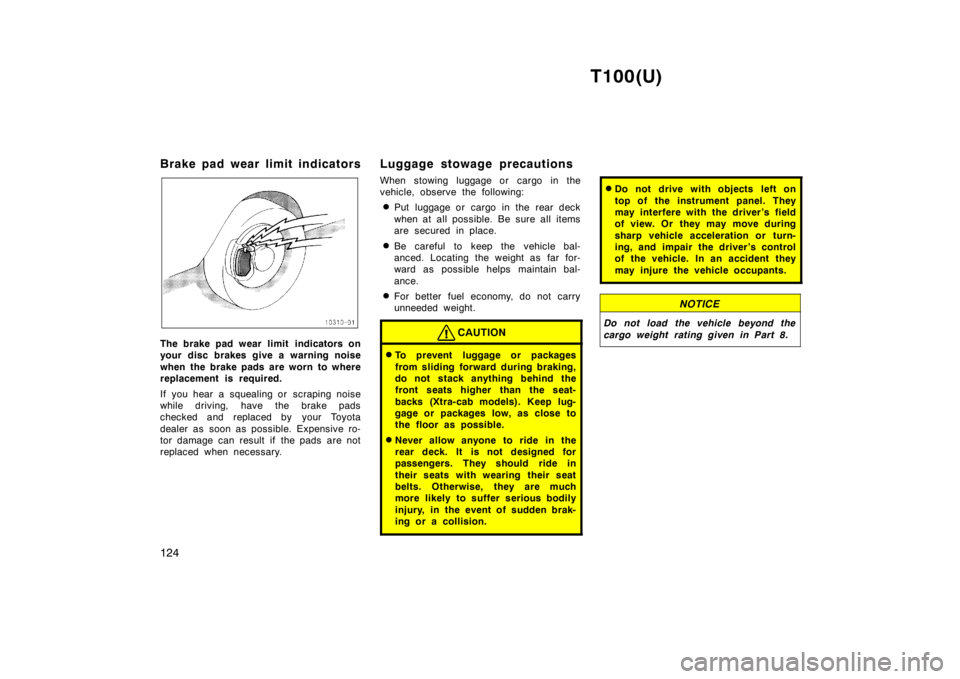
T100(U)
124
Brake pad wear limit indicators
The brake pad wear limit indicators on
your disc brakes give a warning noise
when the brake pads are worn to where
replacement is required.
If you hear a squealing or scraping noise
while driving, have the brake pads
checked and replaced by your Toyota
dealer as soon as possible. Expensive ro-
tor damage can result if the pads are not
replaced when necessary.
Luggage stowage pr
ecautions
When stowing luggage or cargo in the
vehicle, observe the following: � Put luggage or cargo in the rear deck
when at all possible. Be sure all items
are secured in place.
� Be careful to keep the vehicle bal-
anced. Locating the weight as far for-
ward as possible helps maintain bal-
ance.
� For better fuel economy, do not carry
unneeded weight.CAUTION
�To prevent luggage or packages
from sliding forward during braking,
do not stack anything behind the
front seats higher than the seat-
backs (Xtra-cab models). Keep lug-
gage or packages low, as close to
the floor as possible.
� Never allow anyone to ride in the
rear deck. It is not designed for
passengers. They should ride in
their seats with wearing their seat
belts. Otherwise, they are much
more likely to suffer serious bodily
injury, in the event of sudden brak-
ing or a collision.
�Do not drive with objects left on
top of the instrument panel. They
may interfere with the driver’s field
of view. Or they may move during
sharp vehicle acceleration or turn-
ing, and impair the driver’s control
of the vehicle. In an accident they
may injure the vehicle occupants.
NOTICE
Do not load the vehicle beyond the
cargo weight rating given in Part 8.
Page 134 of 214

T100(U)
134
Use a washer fluid containing an anti-
freeze solution.
This product is available at your Toyota
dealer and most auto parts stores. Follow
the manufacturer ’s directions for how
much to mix with water.
NOTICE
Do not use engine antifreeze or any
other substitute as washer fluid be-
cause it may damage your vehicle’s
paint.
Do not use your parking brake when
there is a possibility it could freeze.
When parking, put the transmission into
”P” (automatic) or into first or reverse
(manual) and block the front wheels. Do
not use the parking brake, or snow or
water accumulated in and around the
parking brake mechanism may freeze,
making it hard to release.
Keep ice and snow from accumulating
under the fenders.
Ice and snow built up under your fenders
can make steering difficult. During bad
winter driving, stop and check under the
fenders occasionally.
Depending on where you are driving,
we recommend you carry some emer-
gency equipment.
Some of the things you might put in the
vehicle are tire chains, window scraper,
bag of sand or salt, flares, small shovel,
jumper cables, etc.
Trailer towing
Your vehicle is designed primarily as a
passenger-and-load-carrying vehicle. Tow-
ing a trailer will have an adverse effect on
handling, performance, braking, durability
and driving economy (fuel consumption,
etc.). Your safety and satisfaction depend
on the proper use of correct equipment
and cautious driving habits. For your safe-
ty and the safety of others, you must not
overload your vehicle or trailer. Ask your
local Toyota dealer for further details be-
fore towing.
WEIGHT LIMITS
Before towing, make sure the total trail-
er weight, gross combination weight,
gross vehicle weight, gross axle weight
and trailer tongue load are all within
the limits.
The total trailer weight and tongue load
can be measured with platform scales
found at a highway weighing station, build-
ing supply company, trucking company,
junk yard, etc.
Page 135 of 214
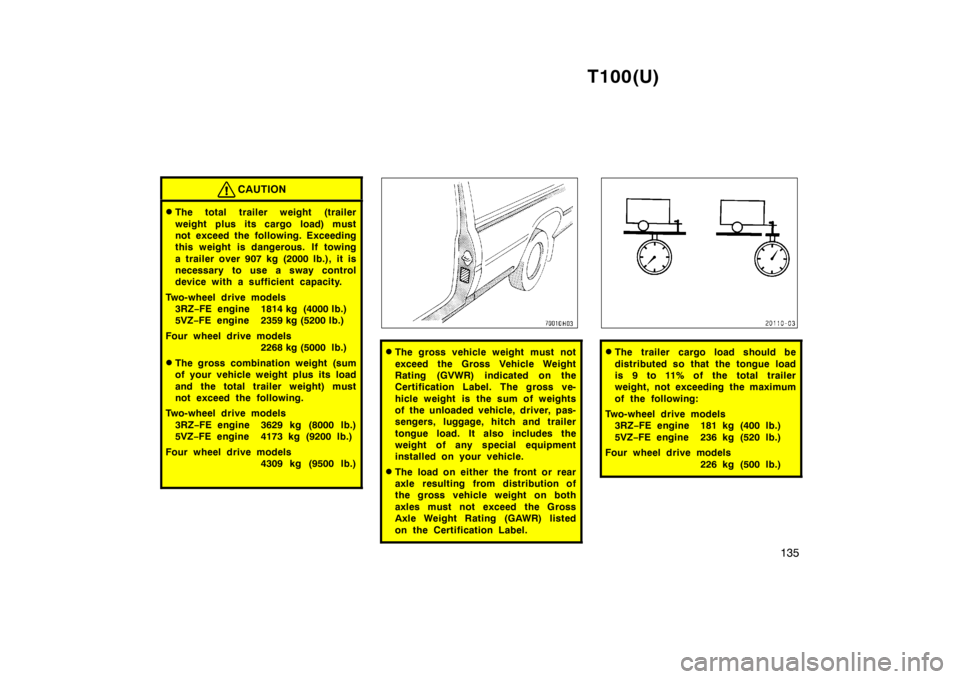
T100(U)135
CAUTION
�The total trailer weight (trailer
weight plus its cargo load) must
not exceed the following. Exceeding
this weight is dangerous. If towing
a trailer over 907 kg (2000 lb.), it is
necessary to use a sway control
device with a sufficient capacity.
Two-wheel drive models 3RZ −FE engine 1814 kg (4000 lb.)
5VZ −FE engine 2359 kg (5200 lb.)
Four wheel drive models 2268 kg (5000 lb.)
� The gross combination weight (sum
of your vehicle weight plus its load
and the total trailer weight) must
not exceed the following.
Two-wheel drive models 3RZ −FE engine 3629 kg (8000 lb.)
5VZ −FE engine 4173 kg (9200 lb.)
Four wheel drive models 4309 kg (9500 lb.)
�The gross vehicle weight must not
exceed the Gross Vehicle Weight
Rating (GVWR) indicated on the
Certification Label. The gross ve-
hicle weight is the sum of weights
of the unloaded vehicle, driver, pas-
sengers, luggage, hitch and trailer
tongue load. It also includes the
weight of any special equipment
installed on your vehicle.
� The load on either the front or rear
axle resulting from distribution of
the gross vehicle weight on both
axles must not exceed the Gross
Axle Weight Rating (GAWR) listed
on the Certification Label.�The trailer cargo load should be
distributed so that the tongue load
is 9 to 11% of the total trailer
weight, not exceeding the maximum
of the following:
Two-wheel drive models 3RZ −FE engine 181 kg (400 lb.)
5VZ −FE engine 236 kg (520 lb.)
Four wheel drive models 226 kg (500 lb.)
Page 136 of 214
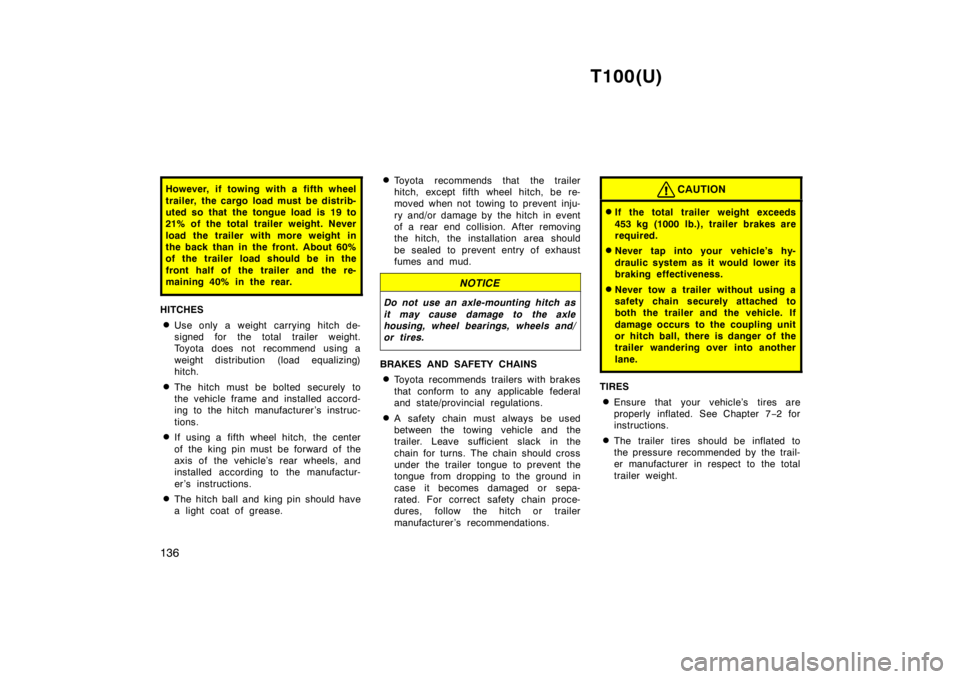
T100(U)
136
However, if towing with a fifth wheel
trailer, the cargo load must be distrib-
uted so that the tongue load is 19 to
21% of the total trailer weight. Never
load the trailer with more weight in
the back than in the front. About 60%
of the trailer load should be in the
front half of the trailer and the re-
maining 40% in the rear.
HITCHES � Use only a weight carrying hitch de-
signed for the total trailer weight.
Toyota does not recommend using a
weight distribution (load equalizing)
hitch.
� The hitch must be bolted securely to
the vehicle frame and installed accord-
ing to the hitch manufacturer ’s instruc-
tions.
� If using a fifth wheel hitch, the center
of the king pin must be forward of the
axis of the vehicle’s rear wheels, and
installed according to the manufactur-
er ’s instructions.
� The hitch ball and king pin should have
a light coat of grease. �
Toyota recommends that the trailer
hitch, except fifth wheel hitch, be re-
moved when not towing to prevent inju-
ry and/or damage by the hitch in event
of a rear end collision. After removing
the hitch, the installation area should
be sealed to prevent entry of exhaust
fumes and mud.
NOTICE
Do not use an axle-mounting hitch as
it may cause damage to the axle
housing, wheel bearings, wheels and/
or tires.
BRAKES AND SAFETY CHAINS
� Toyota recommends trailers with brakes
that conform to any applicable federal
and state/provincial regulations.
� A safety chain must always be used
between the towing vehicle and the
trailer. Leave sufficient slack in the
chain for turns. The chain should cross
under the trailer tongue to prevent the
tongue from dropping to the ground in
case it becomes damaged or sepa-
rated. For correct safety chain proce-
dures, follow the hitch or trailer
manufacturer ’s recommendations.
CAUTION
�If the total trailer weight exceeds
453 kg (1000 lb.), trailer brakes are
required.
� Never tap into your vehicle’s hy-
draulic system as it would lower its
braking effectiveness.
� Never tow a trailer without using a
safety chain securely attached to
both the trailer and the vehicle. If
damage occurs to the coupling unit
or hitch ball, there is danger of the
trailer wandering over into another
lane.
TIRES
� Ensure that your vehicle’s tires are
properly inflated. See Chapter 7 −2 for
instructions.
� The trailer tires should be inflated to
the pressure recommended by the trail-
er manufacturer in respect to the total
trailer weight.
Page 139 of 214
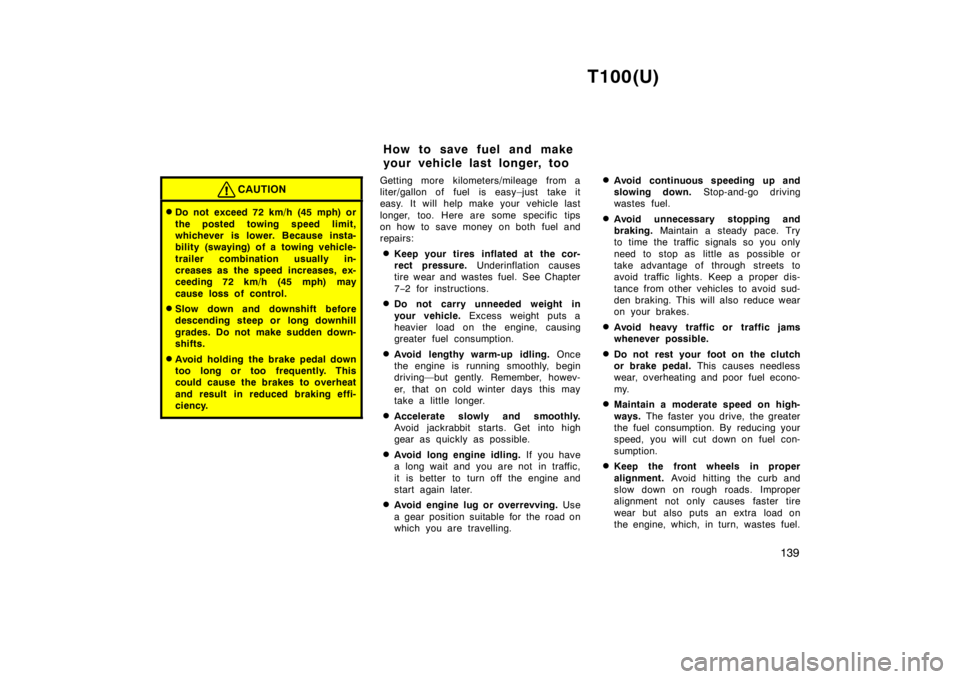
T100(U)139
CAUTION
�Do not exceed 72 km/h (45 mph) or
the posted towing speed limit,
whichever is lower. Because insta-
bility (swaying) of a towing vehicle-
trailer combination usually in-
creases as the speed increases, ex-
ceeding 72 km/h (45 mph) may
cause loss of control.
� Slow down and downshift before
descending steep or long downhill
grades. Do not make sudden down-
shifts.
� Avoid holding the brake pedal down
too long or too frequently. This
could cause the brakes to overheat
and result in reduced braking effi-
ciency.
Getting more kilometers/mileage from a
liter/gallon of fuel is easy–just take it
easy. It will help make your vehicle last
longer, too. Here are some specific tips
on how to save money on both fuel and
repairs:
� Keep your tires inflated at the cor-
rect pressure. Underinflation causes
tire wear and wastes fuel. See Chapter 7 −2 for instructions.
� Do not carry unneeded weight in
your vehicle. Excess weight puts a
heavier load on the engine, causing
greater fuel consumption.
� Avoid lengthy warm-up idling. Once
the engine is running smoothly, begin
driving—but gently. Remember, howev-
er, that on cold winter days this may
take a little longer.
� Accelerate slowly and smoothly.
Avoid jackrabbit starts. Get into high
gear as quickly as possible.
� Avoid long engine idling. If you have
a long wait and you are not in traffic,
it is better to turn off the engine and
start again later.
� Avoid engine lug or overrevving. Use
a gear position suitable for the road on
which you are travelling. �
Avoid continuous speeding up and
slowing down. Stop-and-go driving
wastes fuel.
� Avoid unnecessary stopping and
braking. Maintain a steady pace. Try
to time the traffic signals so you only
need to stop as little as possible or
take advantage of through streets to
avoid traffic lights. Keep a proper dis-
tance from other vehicles to avoid sud-
den braking. This will also reduce wear
on your brakes.
� Avoid heavy traffic or traffic jams
whenever possible.
� Do not rest your foot on the clutch
or brake pedal. This causes needless
wear, overheating and poor fuel econo-
my.
� Maintain a moderate speed on high-ways. The faster you drive, the greater
the fuel consumption. By reducing your
speed, you will cut down on fuel con-
sumption.
� Keep the front wheels in proper
alignment. Avoid hitting the curb and
slow down on rough roads. Improper
alignment not only causes faster tire
wear but also puts an extra load on
the engine, which, in turn, wastes fuel.
How to save fuel and make
your vehicle last longer, too
Page 140 of 214
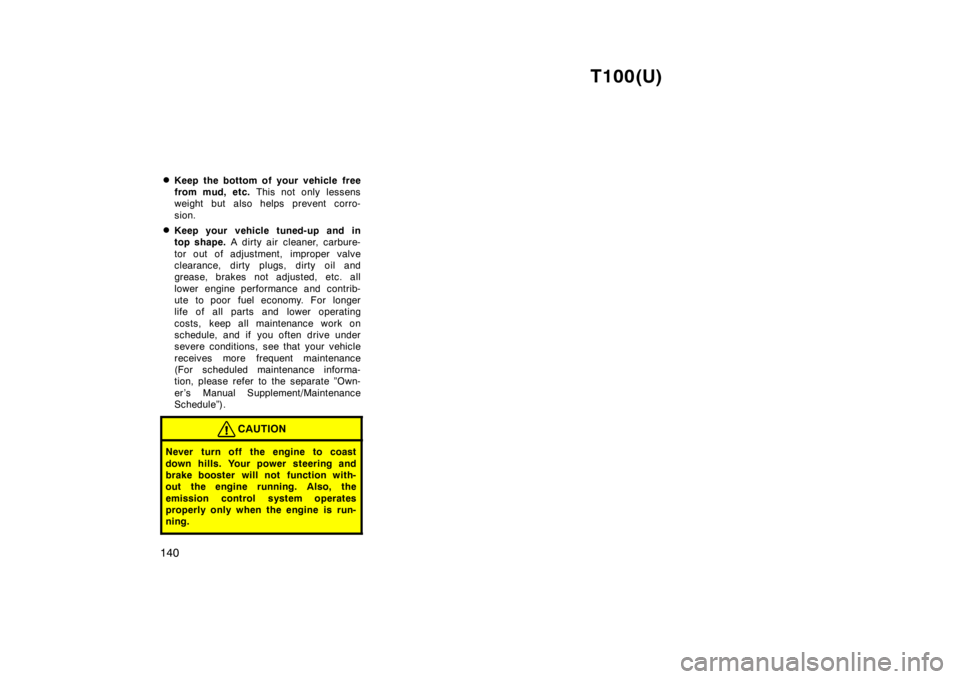
T100(U)
140 �
Keep the bottom of your vehicle free
from mud, etc. This not only lessens
weight but also helps prevent corro-
sion.
� Keep your vehicle tuned-up and in
top shape. A dirty air cleaner, carbure-
tor out of adjustment, improper valve
clearance, dirty plugs, dirty oil and
grease, brakes not adjusted, etc. all
lower engine performance and contrib-
ute to poor fuel economy. For longer
life of all parts and lower operating
costs, keep all maintenance work on
schedule, and if you often drive under
severe conditions, see that your vehicle
receives more frequent maintenance
(For scheduled maintenance informa-
tion, please refer to the separate ”Own-
er ’s Manual Supplement/Maintenance
Schedule”).
CAUTION
Never turn off the engine to coast
down hills. Your power steering and
brake booster will not function with-
out the engine running. Also, the
emission control system operates
properly only when the engine is run-
ning.
Page 183 of 214

T100(U)183
c. Reinstall the filler cap.
d. Remove the filler cap again and look
at the fluid level. If the fluid is cold,
the level should be in the ”COLD”
range on the dipstick. Similarly, if it is
hot, the fluid level should be in the
”HOT” range. If the level is at the low
side of either range, add automatic
transmission fluid DEXRON �
-II or -III
to bring the level within the range.
e. After replacing the filler cap, visually check the steering box case, vane
pump and hose connections for leaks
or damage.
CAUTION
The reservoir tank may be hot so be
careful not to burn yourself.
NOTICE
Avoid overfilling, or the power steer-
ing could be damaged.
Checking tire pressure
Keep your tire pressures at the proper
level.
The recommended cold tire pressures, tire
size and the cargo weight rating are given
in Part 8.
You should check the tire pressures every
two weeks, or at least once a month. And
don’t forget the spare!
Incorrect tire pressure can reduce tire
life and make your vehicle less safe to
drive.
Low tire pressure results in excessive
wear, poor handling, reduced fuel econo-
my, and the possibility of blowouts from
overheated tires. Also, low tire pressure
can cause poor sealing of the tire bead.
If the tire pressure is excessively low,
there is the possibility of wheel deforma-
tion and/or tire separation.
High tire pressure produces a harsh ride,
handling problems, excessive wear at the
center of the tire tread, and a greater
possibility of tire damage from road haz-
ards.
If a tire frequently needs refilling, have it
checked by your Toyota dealer. The following instructions for checking
tire pressure should be observed:
� The pressure should be checked only
when the tires are cold. If your ve-
hicle has been parked for at least 3
hours and has not been driven for
more than 1.5 km or 1 mile since, you
will get an accurate cold tire pressure
reading.
� Always use a tire pressure gauge.
The appearance of a tire can be mis-
leading. Besides, tire pressures that
are even just a few pounds off can
degrade handling and ride.
� Do not bleed or reduce tire pressure
after driving. It is normal for the tire
pressure to be higher after driving.
� Never exceed the cargo weight rat-
ing. The luggage weight should be dis-
tributed evenly.
� Be sure to reinstall the tire inflation
valve caps. Without the valve caps,
dirt or moisture could get into the valve
core and cause air leakage. If the caps
have been lost, have new ones put on
as soon as possible.
Page 187 of 214

T100(U)187
Aluminum wheel precautions
� After driving your vehicle the first 1600
km (1000 miles), check that the wheel
nuts are tight.
� If you have repaired or changed your
tires, check that the wheel nuts are
still tight after driving 1600 km (1000
miles).
� When using tire chains, be careful not
to damage the aluminum wheels.
� Use only the Toyota wheel nuts and
wrench designed for your aluminum
wheels.
� When balancing your wheels, use only
Toyota balance weights or equivalent
and a plastic or rubber hammer.
� As with any wheel, periodically check
your aluminum wheels for damage. If
damaged, replace immediately.